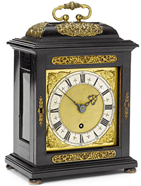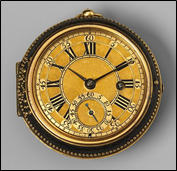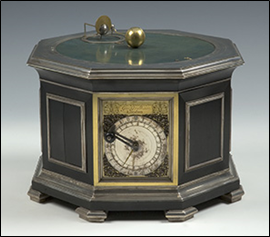


THOMAS TOMPION 1639 -
Acknowledgements
Bracket Clock: Victoria and Albert Museum, London. Pocket Watch: Metropolitan Museum of Art, New York. Orrery: Museum of the History of Science, Oxford University, England.
Including:
George Graham

xxxxxThe talented English clockmaker Thomas Tompion was appointed clockmaker at the Royal Observatory, Greenwich, in 1676. He worked closely with the English inventor Robert Hooke, (assistant to the Irish scientist Robert Boyle), and it was by using one of his designs that he produced one of the first English watches to be regulated by a balance spring. He later developed the cylinder escapement, enabling the making of a flatter, more compact watch. He produced a number of barometers and sundials, and clocks that could run for a year without rewinding. His pioneering work was ably continued by his apprentice George Graham (1674-

 xxxxxThe English clockmaker Thomas Tompion (1639-
xxxxxThe English clockmaker Thomas Tompion (1639-
xxxxxIt was by using one of Hooke's designs that in 1675 he produced one of the first English watches to be regulated by a balance spring. He later developed the cylinder escapement that made possible the use of a horizontal wheel, thus enabling the making of a much flatter and more compact watch. He made a number of clocks that could run for a year without rewinding, and he also produced barometers and sundials.
 xxxxxThe high standard of his pioneering work was continued by his able apprentice, the Englishman George Graham, born in Cumberland in 1674. He went on to perfect the cylinder escapement and invent the dead-
xxxxxThe high standard of his pioneering work was continued by his able apprentice, the Englishman George Graham, born in Cumberland in 1674. He went on to perfect the cylinder escapement and invent the dead-
xxxxxIncidentally, in about 1730 “Honest George Graham” (as he was known in the trade) loaned the English clockmaker John Harrison £200 so that he could start work on his marine timepiece. As we shall see, Harrison designed the first practical marine chronometer in 1762 (G3a).
C2-


